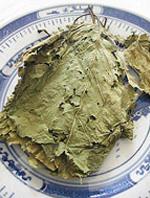Folium Mori
- Name
- Origin
- Where Does It Grow?
- Nature and Flavor
- Identified Active Components / Major Chemical Constituents
- Drug Actions in TCM

- Traditional Uses in TCM
- Pharmacological Actions
- Toxicology
- Administration and Dosage
- Adverse Effect, Side Effects and Cautions
- References
Name
Latin Name: Folium Mori
Common Name: Mulberry leaf

Scientific Name: Morus alba L.
Chinese Name: 桑葉
Pinyin Name: sang ye
Origin
Mulberry leaf belongs to Morus alba L., a small deciduous arbor tree of the Moraceae family. Clinically, it is used either in dried or processed (fried with honey) forms.1,2
Where Does It Grow?
Mulberry leaf is widely distributed in China. Nowadays, it is mainly supplied by cultivation, and produced in provinces like Zhejiang, Jiangsu, Anhui, Hunan, Sichuan and Guangdong.1,5
Nature and Flavor
Mulberry leaf is cold in nature, sweet and bitter in flavor, and mainly manifests its therapeutic actions in the lung and liver meridians.2
Identified Active Components / Major Chemical Constituents
Mulberry leaf has complex components, and the main active components are sterols, flavonoids, volatile oils, coumarins and alkaloids. The sterols include inokosterone, ecdysterone, stigmasterol, campesterol, lupeol,β-sitosterol, myoinositol and β-amyrin. The flavonoids include rutin, quercetin, isoquercitrin, moracetin kuwanon, kaempferol-3-O-β-D-glucopyranoside, and astragalin. The coumarins include bergaten, umbelliferone, scopoletin, scopolin, hydroxycoumarin. The volatile oils include acetic acid, propionicacid, butyric acid, isobutyric acid, valericacid, isovaleric acid, caproic acid, methyl salicylate, guaiacol, ortho cresol, m-cresol, p-cresol, and eugenol. Other ingredients are organic acids like chlorogenic acid, fumaric acid, palmitic acid, ethylpalmitate, folic acid, and folinic acid; polysaccharides, amino acids, vitamins and multiple minerals.4,5,6,7In the Pharmacopoeia of People's Republic of China (2010 Edition) - Part I, the level of rutin should not less than 0.10%, as the standard quality of mulberry leaf.
Drug Actions in TCM
Mulberry leaf dispels wind, clears heat, moistens lungs, soothes liver and promotes eye health.2Traditional Uses in TCM
Pharmacological Actions
Toxicology
10% injection solution of mulberry leaf is given once to mice (body weight 20g) abdominally, the safe dose amount is equivalent to 250 times that used in human. A dose that is equivalent to 60 times of the human usage does is given to mice abdominally, when injected for 21 days continuously, no damages had found in the liver, kidneys and lungs. However, when the dose further increased, the above organs appeared degenerations and bleeding.4
Administration and Dosage
For decoction, the usual dose of mulberry leaf is 6~12g, and can be higher to 16~60g if necessary. Mulberry leaf is also ground to make pills or powder form for oral administration. The herb can be decocted for washing or pounded for topical dressing.2,4When mulberry leaf is processed with honey, its effects on moistening lung and arresting the coughing will be enhanced, therefore processed mulberry leaf is often selected to treat dry coughing.2,4
Adverse Effect, Side Effects and Cautions
Clinical demonstrations show no adverse response when decocting within the suggested does, even for long term consumption or in high does (below 60g) is unlikely to develop obvious adverse responses.4
References
- Li Jiashi (editor-in-chief), Chinese Medicine Identification, Shanghai Scientific and Technical Publishers, 2000-2.
- Lui Daiquan (editor-in-chief), Chinese Herbal Medicine, Shanghai Scientific and Technical Publishers, 2000-6.
- Tao Yufeng, Clinical Herbal Medicine, People’s Medical Publishing House, 2005-5.
- Chen Pian, Clinical Application of Tonifying Herbs, Second Military Medical University Press, 2008-8.
- Zhao Zhongzhen & Xiao Peigen (editor-in-chief), Contemporary Medicinal Herbal Glossary, Hong Kong Jockey Club Institute of Chinese Medicine, 2006-8.
- Nanjing University of Chinese Medicine (edited), Materia Medica, Shanghai Scientific and Technical Publishers, 2005-5.
- http://www.zysj.com.cn/zhongyaocai/yaocai_s/sangye.html
- http://baike.baidu.com/view/37610.htm?fr=aladdin


